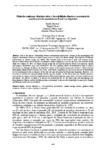Por favor, use este identificador para citar o enlazar este ítem:
http://www.alice.cnptia.embrapa.br/alice/handle/doc/1035251Registro completo de metadatos
| Campo DC | Valor | Lengua/Idioma |
|---|---|---|
| dc.contributor.author | HAMADA, E. | pt_BR |
| dc.contributor.author | GHINI, R. | pt_BR |
| dc.contributor.author | RAGO, A. M. | pt_BR |
| dc.contributor.author | BISONARD, E. M. | pt_BR |
| dc.date.accessioned | 2016-01-26T11:11:11Z | pt_BR |
| dc.date.available | 2016-01-26T11:11:11Z | pt_BR |
| dc.date.created | 2016-01-26 | pt_BR |
| dc.date.issued | 2015 | pt_BR |
| dc.identifier.citation | In: SIMPÓSIO BRASILEIRO DE SENSORIAMENTO REMOTO, 17., 2015, João Pessoa. Anais... São José dos Campos: INPE, 2015. p. 4939-4945. | pt_BR |
| dc.identifier.uri | http://www.alice.cnptia.embrapa.br/alice/handle/doc/1035251 | pt_BR |
| dc.description | Abstract: Due to the intense relationship between environment and disease, changes in the geographical and temporal distribution of disease occurrence may occur as an impact of climate change. The responses of different pathosystems to climate change vary widely. This variation makes it necessary to study each response of the species or plant variety and its diseases in relation to climate change on a case-by-case basis.The objective of this study was evaluate the effect of climate change on the late leaf spot of peanut to Brazil and Argentina. Spatial and temporal distribution maps were obtained by GIS tool, applying criteria of mathematical logic of climate favorability to pathogen incidence, developed by experts, and using the projections of future climate obtained from global climate models from the IPCC AR4. In the future, in general, it is forecast an increase in favorability of the environment to the occurrence of the late leaf spot of peanut for Brazil and Argentina. However, it is necessary to analyze the seasonal pattern and the specific location. In São Paulo state and Córdoba province, main producers regions, and their neighborhoods in Brazil and Argentina, respectively, the future tendencies are not similar. The forecast in future is to increase the favorability for the São Paulo state and surrounding areas from January to March; and for Córdoba province and around, to decrease the favorability is expected in January and February and to increase in March. | pt_BR |
| dc.language.iso | por | pt_BR |
| dc.rights | openAccess | pt_BR |
| dc.subject | Arachis hypogea L | pt_BR |
| dc.subject | Cercosporidium personatum | pt_BR |
| dc.subject | Geoprocessing | pt_BR |
| dc.subject | Mudanças climáticas | pt_BR |
| dc.subject | Geoprocessamento | pt_BR |
| dc.title | Efeito das mudanças climáticas sobre a favorabilidade climática à ocorrência da mancha preta do amendoim no Brasil e na Argentina. | pt_BR |
| dc.type | Artigo em anais e proceedings | pt_BR |
| dc.date.updated | 2016-01-26T11:11:11Z | pt_BR |
| dc.subject.thesagro | Mancha preta | pt_BR |
| dc.subject.thesagro | Amendoim | pt_BR |
| dc.subject.thesagro | Doença de planta | pt_BR |
| dc.subject.thesagro | Clima | pt_BR |
| dc.subject.nalthesaurus | Mycosphaerella berkeleyi | pt_BR |
| dc.subject.nalthesaurus | Plant diseases and disorders | pt_BR |
| dc.subject.nalthesaurus | climate change | pt_BR |
| riaa.ainfo.id | 1035251 | pt_BR |
| riaa.ainfo.lastupdate | 2016-01-26 | pt_BR |
| dc.contributor.institution | EMILIA HAMADA, CNPMA; RAQUEL GHINI, CNPMA; ALEJANDRO MARIO RAGO, INTA; EDUARDO MATIAS BISONARD, INTA. | pt_BR |
| Aparece en las colecciones: | Artigo em anais de congresso (CNPMA)  | |
Ficheros en este ítem:
| Fichero | Descripción | Tamaño | Formato | |
|---|---|---|---|---|
| 2015AA007.pdf | 2.46 MB | Adobe PDF |  Visualizar/Abrir |









